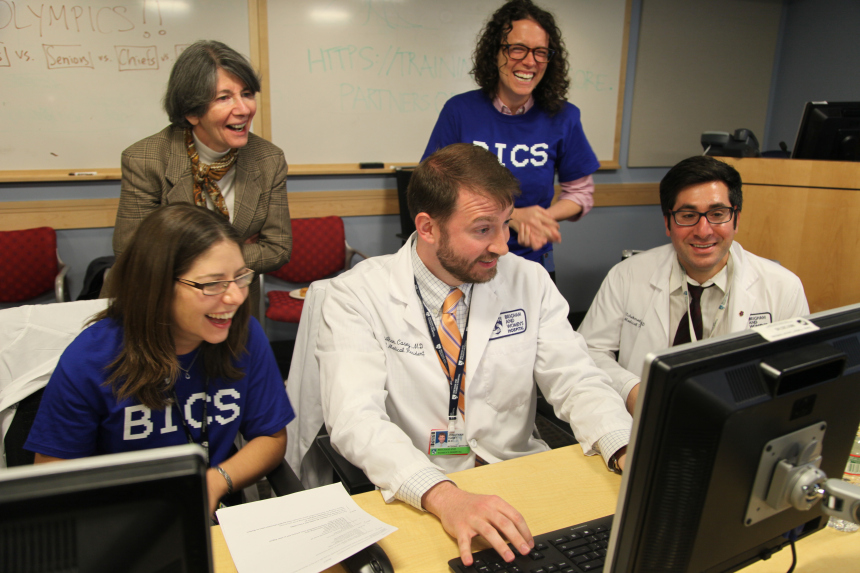An ongoing dialogue on HIV/AIDS, infectious diseases,
May 14th, 2017
Poll: Which Feature of Electronic Health Records is Most Important to Patient Care?
 The first electronic medical record I used regularly — called “BICS” — initially had one purpose. It was a tool to look up a patient’s lab results.
The first electronic medical record I used regularly — called “BICS” — initially had one purpose. It was a tool to look up a patient’s lab results.
Simple, reliable, and blazingly fast, it did one thing remarkably well.
Later, one of our Emergency Department doctors, who happens to have impressive coding skills, worked with a team to add a simple ambulatory medical record (medications, allergies, a problem list, progress notes).
Soon after, they released an astonishingly efficient inpatient order entry system, one that relied on keyboard shortcuts. Use of the mouse was definitely for amateurs.
After a brief learning period that took the interns around a nanosecond, all the clinicians loved it. It was so popular that the medical housestaff even held a party in its honor, something they called “OlymBICS,” with teams competing to see who could enter orders the fastest.
Much of its success, I’d argue, had to do with the simplicity — it didn’t overreach. Today, of course, all the big EHRs (or EMRs, or whatever you want to call them) try to do all things for all people — doctors, nurses, patients, administrative staff. I wouldn’t be surprised if there are features for the hospital cafeteria and catering services.
And because the range of these activities is so broad, EHRs have become bloated, complex, and inefficient. The complexity steals attention away from our patients as we try to satisfy the insatiable screen, keyboard, and mouse.
There’s just so much to do (and so many opportunities to do it wrong), it’s hard to concentrate.
In a piece called “Death By A Thousand Clicks,” some local colleagues write the following:
It happens every day, in exam rooms across the country, something that would have been unthinkable 20 years ago: Doctors and nurses turn away from their patients and focus their attention elsewhere — on their computer screens … EMRs have become the bane of doctors and nurses everywhere. They are the medical equivalent of texting while driving, sucking the soul out of the practice of medicine while failing to improve care.
Yes, we all recognize that feeling!
These problems notwithstanding, it’s clear that not even the crankiest EHR critic would propose that we go back to the days of paper charts, radiology film libraries, or having to call the lab to get patient test results.
Part of what makes the problems with EHRs so frustrating is that there is so much potential for excellent, intuitive, and interoperative systems. EHRs already do some things very well indeed.
The British struggled when their EHRs went down in the recent WannaCry cyberattack, and not just because they were still using an unpatched version of Windows XP.
(XP? Seriously? Yikes.)
So to detail the EHR benefits, and in honor of BICS (may it R.I.P.), I list below several widely available EMR functions.
You, dear reader, will choose the one feature you would miss the most during patient care if it suddenly were no longer available. In the comments section, feel free to elaborate why you chose what you did.
And I’m pretty sure I can predict the loser of this poll.
Save



Although I have never used a EMR I have treated people for this condition.
Seems like a fungus that just keeps on growing in the medical system until someone says “Whoa”.
Would definitely miss being able to enter prescription, lab and radiology orders and send them electronically. I actually wanted to pick the safety alerts, too, since our Rx order-writing system checks for drug interactions.
The most important feature of EMR if done properly is the ability to review the complete record of a complex medical patient with multiple diagnoses (like 20), multiple medications (like 25), multiple consults (like 8) and efficiently go to all the data and then to linked reference material like uptodate to make critical decisions on new medical problems in real time with the medical record and references projected on the wall for the patient to see and correct and plan the care for the patient with written report of all the information and decisions given to patient at end of visit. Copies to all consults.
This DOES NOT MEAN THAT MD’S SHOULD BE WASTING THEIR TIME WITH INFORMATION AND DATA ENTRY. THEY SHOULD DO VIRTUALLY NONE. DIRECT DATA DENTRY FROM LABS AND DATA TRANSFERS FROM HOSPITALS AND CONSULTANTS AND PATIENTS, ADMINISTRATIVE ASSISTANTS, NP’S AND PA’S, SCRIBES, ETC DO ALL DATA ENTRY REVIEWED BY MDS. MD’S GET PAID BY THE HOUR AT GENEROUS RATE TO REVIEW DATA FOR ACCURACY AND TO MAKE THE CRITICAL DECISIONS ON WHAT IS INDICATED BY EVIDENCE AND WHAT IS NOT AND SHOULD NOT BE DONE. Let’s fix the system so this is how it works. It is up to us – the physicians.
I agree with Dr Steinmuller that the primary role of the EHR is to document patient care, and that this is particularly important with the most complex patients. Having this information at hand allows us to make the complex care decisions that will help our patients, and secondarily our healthcare system.
However, although scribes would be fantastic to have, I do not believe that getting a scribe for every physician (or even most) is the answer. This cost will likely be borne by the healthcare system, not patients, and because we physicians have not been at the head of the health care decision table (or even at the table, in some cases) for some time, that means that we are the most likely to held responsible for the increased costs.
In my opinion, the creation of an improved EHR must be largely the purview of currently practicing physicians, not physician managers or system leaders who practice little or no medicine presently, and especially not non-physician administrators. I also recommend that at least half of the physicians creating the optimal EHR should NOT be highly computer-savvy. The design & implementation of an optimal EHR is best carried out by a collaboration of those who are likely to be most challenged by it, and those who are much more comfortable with the concept.
Furthermore, I urge that if an optimal EHR is ever in the works, that the majority of the designers should be primary care physicians. It is likely to be much easier to fine-tune a software designed for broader use and excise the parts not useful to a given specialty, as compared to having a program designed very well for one specialty (is there really a very well-designed EHR out there?) but being less user-friendly & less utilitarian for everybody else. I believe the EHR we use in our underserved clinic was designed largely by a specialist and software designers, and the resulting platform is clunky, slow, excessively click-dependent, and far more difficult to use than it could/should be. We do not use Epic in our clinic, but we do in the hospital, and everybody who has used both has a strong preference for Epic. Nevertheless, while superior to most other EHR’s that anybody has tried, even Epic has its issues, greatest of which is (as is the premise of the original article above) that it removes us from our pts in the exam room.
In my experience as a patient, the EMR only contains test results done in-house and any outside tests are not included. Therefore, I never get the full picture for figuring out trends and sadly, neither does my doctor.
Electronic prescription writing, because I can not take an actual paper copy, that I can read, to the pharmacy and know if they fill it correctly has resulted in some prescriptions being wrong, but I can’t tell. Very dangerous!! No checks and balances.